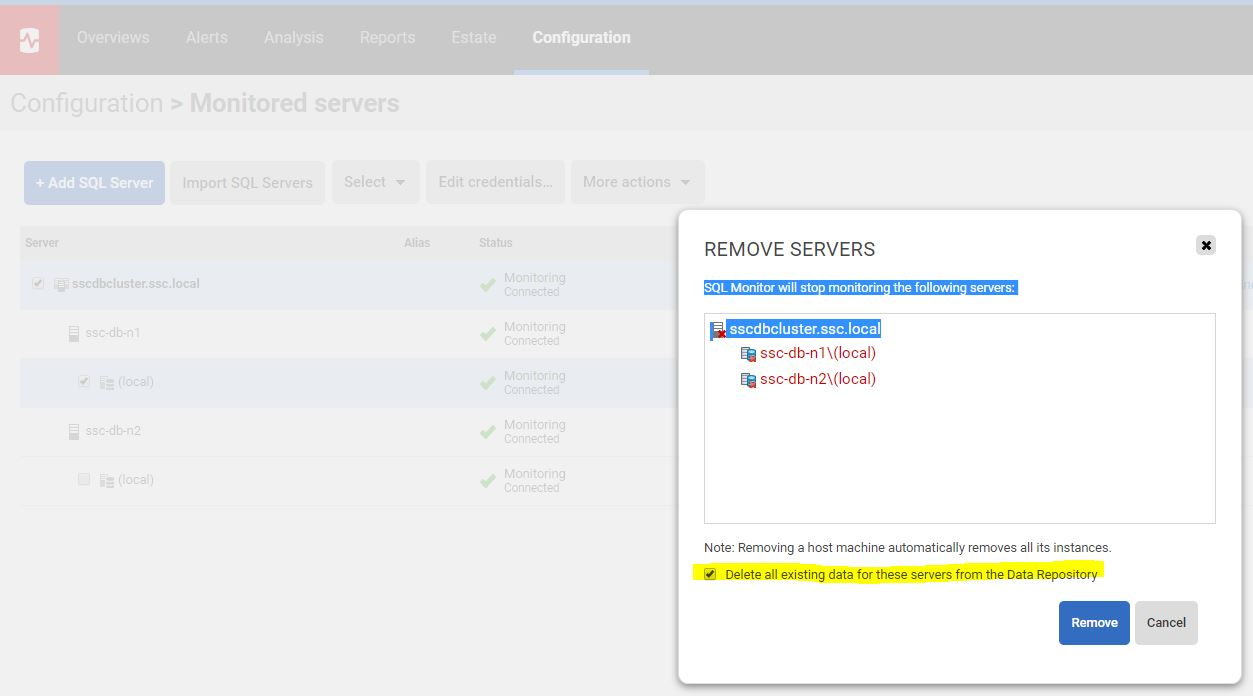Hi, Is it possible to delete a uninstalled SQL instance from SQLMonitor? A few months ago we decided to uninstall a SQL instance and still it's visible in SQL Monitor.
Comments
11 comments
-
 Hi PaulL,
Hi PaulL,
Thanks for posting on the Redgate forums.
The instance will be removed when the purge settings delete all of the data from the SQL Monitor repository.
You can check your purge settings on Configuration>Purging. -
 Hi PaulL,
Hi PaulL,
Thanks for posting on the Redgate forums.
The instance will be removed when the purge settings delete all of the data from the SQL Monitor repository.
You can check your purge settings on Configuration>Purging. -
 This is not working for me. I removed an instance from one of my monitored servers over a month ago (which is what is set on the Purge settings - 1 month) and it is still there. How can I remove it from the monitor?
This is not working for me. I removed an instance from one of my monitored servers over a month ago (which is what is set on the Purge settings - 1 month) and it is still there. How can I remove it from the monitor?
-
 I think we've got a bug here, we're trying to pinpoint it.
I think we've got a bug here, we're trying to pinpoint it. -
 Did you check the box Delete all existing data for these servers from the Data Repository when you removed the Monitored servers?
Did you check the box Delete all existing data for these servers from the Data Repository when you removed the Monitored servers?
-
 it looks like the only way to get rid of an instance in SQL Monitor is if it exists as a single instance. this way the "Remove Servers" option is available. if its a multi-instance server , the remove server option is greyed out . ideally a "Remove Instance" option would be ideal.
it looks like the only way to get rid of an instance in SQL Monitor is if it exists as a single instance. this way the "Remove Servers" option is available. if its a multi-instance server , the remove server option is greyed out . ideally a "Remove Instance" option would be ideal. -
 Do you mean remove a single server (from a cluster?), rather than [sql] instance?
Do you mean remove a single server (from a cluster?), rather than [sql] instance? -
 This is still an issue. I had a cluster with 4 nodes in it. I removed 2 nodes because they were no longer needed. These 2 nodes are still showing up. I don't want to purge all data now, i just want to remove these servers from within Redgate SQL Monitoring.
This is still an issue. I had a cluster with 4 nodes in it. I removed 2 nodes because they were no longer needed. These 2 nodes are still showing up. I don't want to purge all data now, i just want to remove these servers from within Redgate SQL Monitoring. -
 Same issue here, I removed a server from a cluster, and it is now just sitting there greyed out on the main overview. The most irritating part is it still takes up a license that I cannot use on a real server.
Same issue here, I removed a server from a cluster, and it is now just sitting there greyed out on the main overview. The most irritating part is it still takes up a license that I cannot use on a real server. -
 To resolve this issue do the following:
To resolve this issue do the following:
First, take a backup of the data repository (RedGateMonitor database by default) in case anything should go awry.
Then, we will need to find the entry for that instance in the repository in the settings.SqlServers table - which will look like:And then you would want to delete by Id the entry in that table that has name that matches the two nodes that no longer exist (which represents the default instance on that server, if it was a named instance it would have the instance name after the backslash e.g. serverName\instanceName)SELECT * FROM settings.SqlServers AS ss
WHERE Name = 'FirstNodeName\' OR Name = 'SecondNodeName\';DELETE FROM settings.SqlServers
WHERE Id = '<theIdFromFirstNodeAbove>' OR
Id = '<theIdFromSecondNodeAbove>';
This worked for me and was given as a solution by the support team in the past.
Good luck! -
 Thank you for the solution! It worked perfectly for me.
Thank you for the solution! It worked perfectly for me.
Add comment
Please sign in to leave a comment.